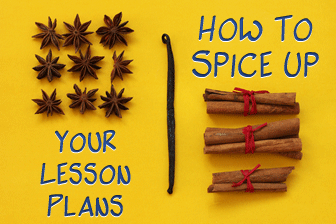R: Ridiculous Recipes - Giving Instructions for Crazy Concoctions [Teacher Tips from A to Z]
![R: Ridiculous Recipes - Giving Instructions for Crazy Concoctions [Teacher Tips from A to Z]](/uploads/posts/2011-08/1312601502_esl-cooking-class.png)

Though you probably cannot afford to take your class on a trip around the world, these activities may have you all feeling as if you are walking on air, and they will certainly get your mouth watering!
Begin your spicy unit by asking your students what they noticed about the food when they first came to the United States. Some may say the food was bland while others say it was spicy. Depending on the region from which each person originated, your students will each have a different opinion of the food they now probably eat on a daily basis. Give your students a chance to share what differences they noticed in the food, making sure each person in class gets the opportunity to share.
Move the discussion in a spicier direction by asking your students to brainstorm a list of as many spices as they can think of. This may be a challenge even for the cooks among your students since they may not know the English vocabulary for familiar spices. The list you eventually compile should include basics like salt and pepper as well as more exotic ingredients like curry and cayenne. See just how large of a list your class can compile, and keep adding to the list as you work your way through the remaining exercises.
To help your students add to the list, bring in some samples from your spice cabinet. If you enjoy cooking, you may have dozens of spices to share with your students. If you have fewer options in your cabinets, ask a fellow teacher who is a more experienced cook to spare a few pinches of as many different spices as he or she can. Take a small sample of each spice and put it into a small zipper top bag. You should pass each bag around your classroom and see if your students are able to identify the spices they smell. If so, add each to the list. If your students cannot identify the spice they smell, give them the name. For each spice, ask your students to name a food that they have eaten which uses the spice. If you have students who like to cook, they may also be able to share recipes they have followed that use the different spices.
A great resource for learning more about spices is Spice Advice Spice Encyclopedia. You can give your students some reading practice by sending each person to the website to learn about the origin and the uses of the spices on your list. You may want to have one person choose each spice and then share key information about it with the class. You may also want to have groups of students look up the same set of five or ten spices. If you like, format a chart for the groups to fill in. Include columns for general information, place of origin and possible uses. After each person has some information on at least one spice, do a different type of reading practice by scanning recipes for those that call for a given spice. You can probably find many cookbooks at your local library if you do not have enough of your own. Have a few cookbooks available to your students to use in class, and remind your students that scanning is a reading strategy in which the reader looks for specific information. You can then have your students scan the ingredient lists of the recipes for any that call for their spice. You might also want to show them how to use the index in the back of the book to find recipes that use the spice they are looking for.
You may want to finish your spicy lesson by inviting students to share a food from their native culture with the rest of the class. Hold a food festival in which volunteers bring in a dish for which their culture is known. Make sure each person who brings in food includes a list of the ingredients necessary to make it. Not only will this allow you to identify any allergy issues you or your students may have, you can also challenge your students to find the spices that went into each of the dishes. Then have your students compare their charts which list the origins of each spice with the region of the world that makes a given dish which includes it.
For a little follow up writing practice, challenge your students to some descriptive writing about one of the foods they tasted. Start by brainstorming as many different words as possible that describe how something tastes. You may want to refer your students to a thesaurus for more ideas once they have offered all the words they already know. Then have each person write as much detail as possible about the taste of a given food in the classroom without naming that food. After the writers are finished, have them read their pieces to the rest of the class and see if the class can identify the food they wrote about.
Give your students a chance to expand their palates as well as their vocabularies by bringing some of the world’s spices into your classroom and doing some tasteful lessons!